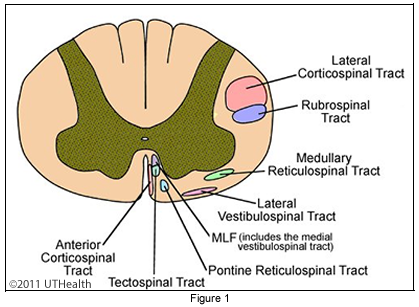Lab 6 (ƒ9) Descending Pathways to the Spinal Cord
Review of Descending Spinal Cord Tracts
In the next few sections we will review what we’ve learned about descending (this lab) and ascending (previous labs) tracts. The figure shows the descending tracts as they appear in the spinal cord.
 Broadly, we divide the descending tracts into corticospinal and non-corticospinal tracts. We will review the corticospinal tract in more detail in the next section. The non-corticospinal portion of the somatic motor system includes all descending spinal pathways that involve spinal tracts, which do not originate in the cerebral cortex. This grouping results in categorizing fiber pathways, which arise from different nuclear groups in the brain stem. These pathways include: the reticulospinal, vestibulospinal, rubrospinal and tectospinal (minor) pathways. The role of these pathways in regulating posture, muscle tone and spinal reflex activity will be described in their respective sections. However, it is important to realize that these pathways play an even greater role than that of the corticospinal pathway in maintaining the ability to coordinate and execute volitional movement of the limbs and body. It is the interaction of the higher centers (cerebral cortex, thalamus, basal ganglia, red nucleus, inferior olives, cerebellum, vestibular nuclei and reticular formation) which determine this ability. In looking only at the descending pathways and their effects on posture, muscle tone and reflex activity, we are viewing only a small portion of the role these pathways play in motor function. The entire non-corticospinal system is of primary importance to normal functioning. Most neurological disease states characterized by spasticity and paralysis are manifestations of abnormal function in some part of the non-corticospinal motor system.
Broadly, we divide the descending tracts into corticospinal and non-corticospinal tracts. We will review the corticospinal tract in more detail in the next section. The non-corticospinal portion of the somatic motor system includes all descending spinal pathways that involve spinal tracts, which do not originate in the cerebral cortex. This grouping results in categorizing fiber pathways, which arise from different nuclear groups in the brain stem. These pathways include: the reticulospinal, vestibulospinal, rubrospinal and tectospinal (minor) pathways. The role of these pathways in regulating posture, muscle tone and spinal reflex activity will be described in their respective sections. However, it is important to realize that these pathways play an even greater role than that of the corticospinal pathway in maintaining the ability to coordinate and execute volitional movement of the limbs and body. It is the interaction of the higher centers (cerebral cortex, thalamus, basal ganglia, red nucleus, inferior olives, cerebellum, vestibular nuclei and reticular formation) which determine this ability. In looking only at the descending pathways and their effects on posture, muscle tone and reflex activity, we are viewing only a small portion of the role these pathways play in motor function. The entire non-corticospinal system is of primary importance to normal functioning. Most neurological disease states characterized by spasticity and paralysis are manifestations of abnormal function in some part of the non-corticospinal motor system.
